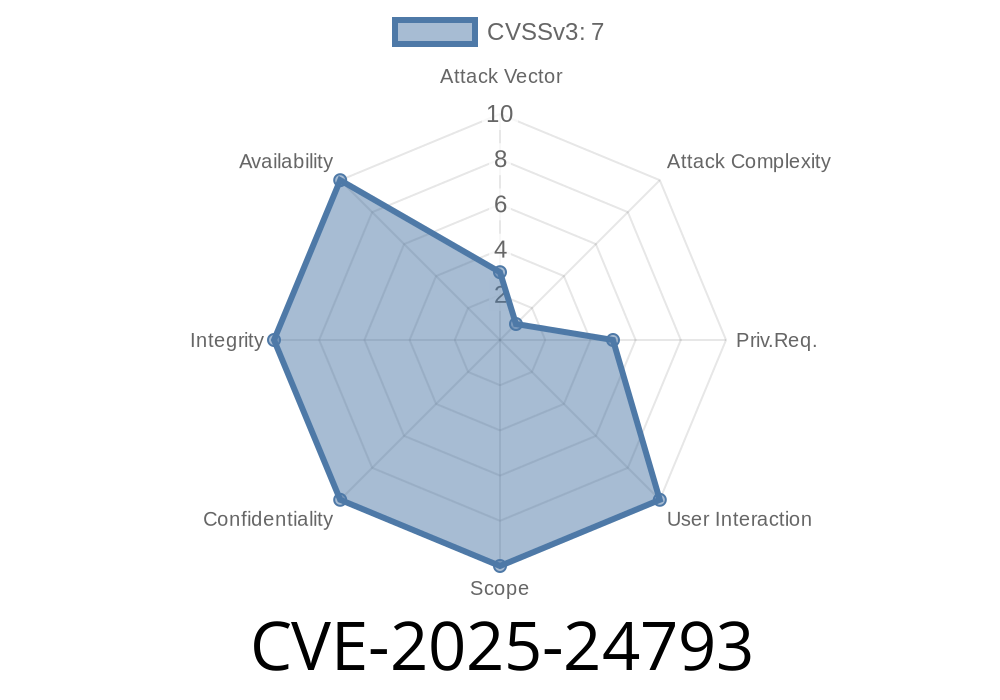If you're building Python apps that talk to data in the Snowflake cloud platform, chances are you’re using the Snowflake Connector for Python. It’s a popular, handy library—so imagine the shock when a critical bug showed up, allowing SQL injection attacks if you weren’t careful with user input.
In this exclusive read, we’ll break down everything you need to know about CVE-2025-24793, including code samples, how the vulnerability works, and what you should do to keep your data safe.
What Is CVE-2025-24793?
CVE-2025-24793 is a security vulnerability found in the snowflake.connector.pandas_tools module, part of the Snowflake Python Connector library (versions 2.2.5 through 3.13.). This bug lets an attacker inject arbitrary SQL code through unsafe parameters, potentially exposing or corrupting your sensitive data.
Snowflake patched the vulnerability in version 3.13.1, so updating is critical.
What Makes This a “Big Deal”?
SQL injection is a classic—yet dangerous—type of vulnerability. If you’re building applications that let end-users control any part of the SQL statement, you have to be super careful not to give them a way to mess with your database.
With this flaw in Snowflake’s connector, certain function(s) in the pandas_tools module didn’t properly sanitize or parameterize SQL statements, opening the door for attack.
Where’s the Bug?
The vulnerable function is write_pandas, widely used to load pandas DataFrames into Snowflake tables.
Here’s a simplified version of how someone might use it
from snowflake.connector.pandas_tools import write_pandas
success, nchunks, nrows, _ = write_pandas(conn, df, table_name="user_data")
Normally, write_pandas takes care of escaping and building SQL—but one or more parameters (like table_name) weren’t being checked properly in affected versions.
If an attacker could supply a value for table_name, they could inject malicious SQL. For example:
# Dangerous! Assume 'user_input' comes from an untrusted source.
malicious_table = "safe_table; DROP TABLE important_data; --"
write_pandas(conn, df, table_name=malicious_table)
If you’re unlucky, the above would drop (delete) your important_data table.
Suppose you have a web app where users can upload data, and pick which table it imports into
# BAD: Directly using user input for the table name is dangerous.
user_table = request.form['table'] # Comes from a web form
write_pandas(conn, df, table_name=user_table)
Now, an attacker sends this as the table name
example_table; UPDATE users SET role='admin' WHERE username='hacker'; --
If your code is running a vulnerable Snowflake Connector, the module may execute that second statement, making hacker an admin.
References
- Snowflake Security Advisory (official announcement, fix instructions)
- Snowflake Python Connector Docs
- CVE-2025-24793 at NVD (National Vulnerability Database)
How Can I Fix My Code?
1. Upgrade Immediately.
First, upgrade the Snowflake Connector for Python to 3.13.1 or later.
pip install --upgrade snowflake-connector-python
2. Validate User Input.
Never use raw user input for anything involving SQL or object (table) names. If you must, whitelist valid table names you allow.
allowed_tables = ['data_2024', 'archive', 'transactions']
if user_table in allowed_tables:
write_pandas(conn, df, table_name=user_table)
else:
raise Exception("Invalid table name")
3. Always Parameterize SQL.
Be careful with dynamic SQL and use connector methods that safely handle parameters.
Conclusion: Stay Secure and Keep Updating
CVE-2025-24793 is a reminder that “easy” data integration tools aren’t immune to security bugs. Even if you trust the library, keep up with version updates, review your code for unsafe practices, and always, always treat user input with suspicion.
If you manage or help develop Python apps that use the Snowflake Connector, update today. You’ll be protecting your team, your users, and your company’s data.
For more details:
- Official Snowflake Security Advisory on CVE-2025-24793
- Snowflake Python Connector GitHub
Feel free to comment below if you’ve got questions or want a deeper dive into SQL injection and cloud security!
Timeline
Published on: 01/29/2025 21:15:21 UTC
